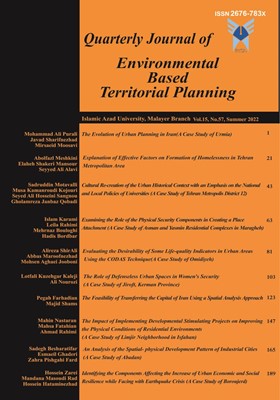Evaluating the Desirability of Some Life-quality Indicators in Urban Areas Using the CODAS Technique (A Case Study of Omidiyeh)
Subject Areas :
alireza shirali
1
,
Abbas Maroofnezhad
2
*
![]() ,
Mohsen aghaei juboni
3
,
Mohsen aghaei juboni
3
![]()
1 - M.Sc., Department of Geography & urban planning, Mahshahr Branch, Islamic Azad University, Mahshahr, Iran
2 - Department of Geography & urban planning, Mahshahr Branch, Islamic Azad University, Mahshahr, Iran
3 - Department of Geography & urban planning, Mahshahr Branch, Islamic Azad University, Mahshahr, Iran
Keywords: Evaluation, quality of life, urban areas, Omidiyeh,
Abstract :
The city, as the highest manifestation of civilization, plays an essential role in creating a good life for the citizens. Today, to solve the problems of urban dwellers and improve their life quality, the concept of quality of life has been given more attention by urban planners. Considering the importance of the subject, three selected research indicators (physical-economic, service-biological, and social-cultural) and 36 variables in four urban areas of Omidiye have been analyzed from the perspective of quality of life. The type of research is applied and based on the research method, it is a survey with an emphasis on questionnaires. The statistical population of the study involves citizens living in the city of Omidiyeh and calculating the sample size was done using Cochran's formula based on which 380 people were selected. To check the normality of the data distribution, the Kolmogorov-Smirnov (KS) test was used, and the Sign Test was used to check the status of the research variables. Also, variable weighting was done using Shannon's entropy model and ranking of urban areas was performed using the CODAS technique. The general results of the Sign test show that the two city districts of Omidiyeh with an average of 3.59 had a better situation in quality of life indicators compared with the other three districts. Also, the results of the CODAS technique show that the second region with the value of 0.528 in Hi (values of the criteria of the options), the first region with 0.456, the third region with a value of 0.016, and the fourth region with -1 rank first to fourth respectively. The second to fourth ranks have been used as the research indicators and variables of quality of life.
_||_

